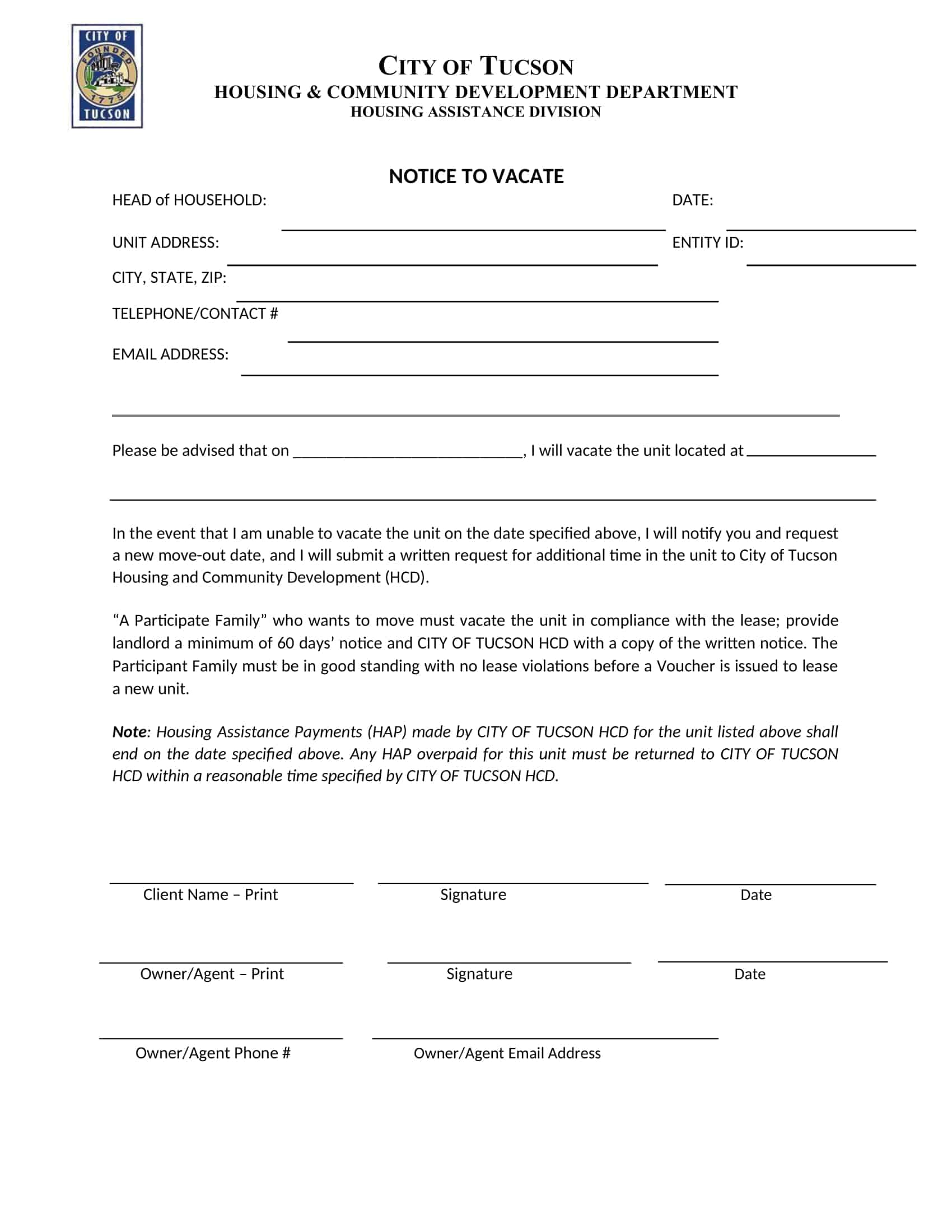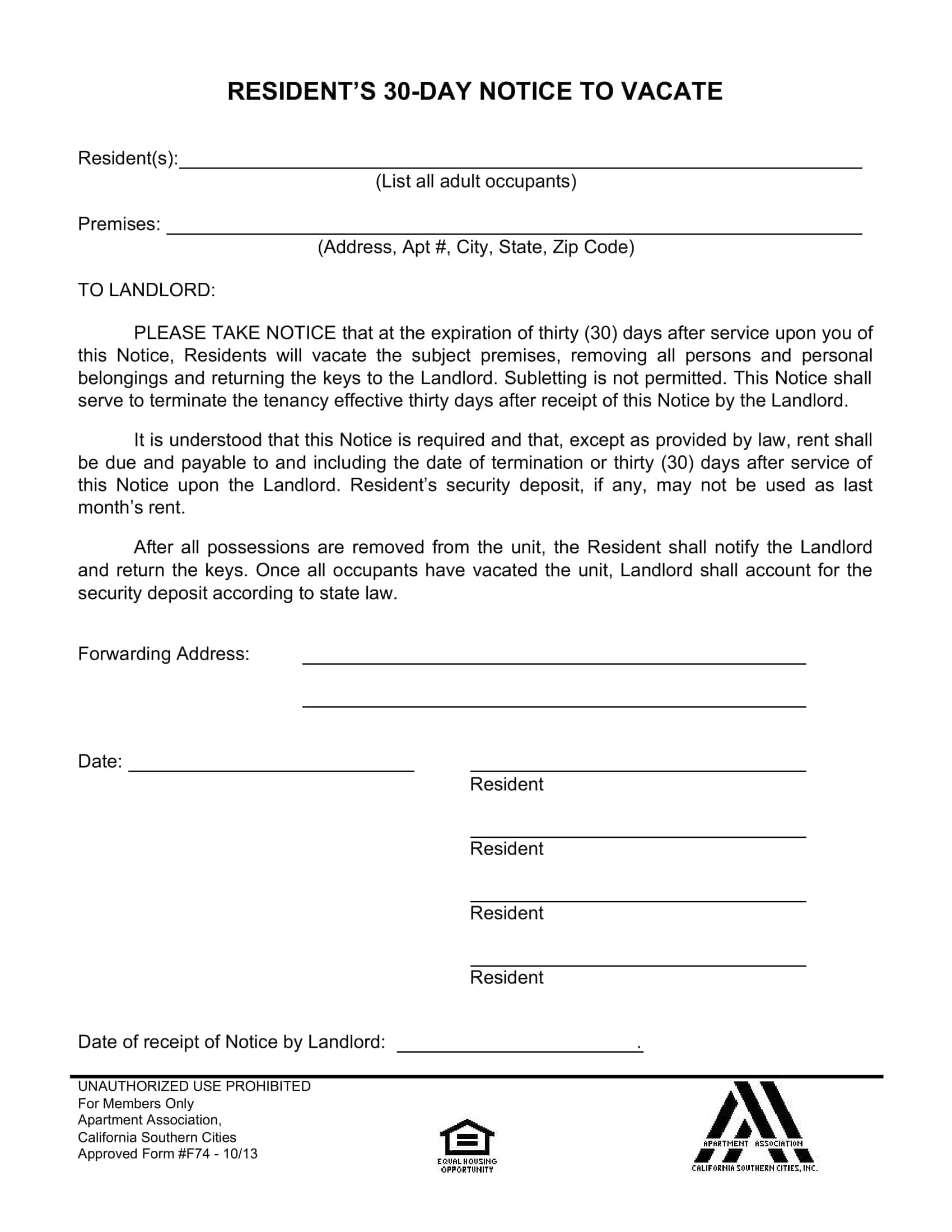As a landlord, you are legally under the obligation to give notice to your tenant when they have violated a term of the lease agreement. You do it with the help of a notice to vacate document that sets out the reasons and describes the consequences for not abiding with it. Otherwise, if you let your tenant live on the premises regularly without citing any particular reason and then propose an intent to terminate their stay or evict them from your property, you might face legal consequences.
However, as a tenant, if you want to leave the house but cannot come up with a letter mentioning your intentions clearly, use the notice to vacate template provided here. The letter is meant to issue advance notice by which the lease can be ended before its expiry date. It lets everybody know about your intent to vacate, which may leave other tenants confused about where they stand in terms of their contractual obligations.
Table of Contents
Notice to Vacate Letter Templates
Simplify the process of notifying tenants with our comprehensive collection of Notice to Vacate Letter Templates. These free, printable templates provide a professional and straightforward format for landlords and property managers to communicate important information to tenants.
Whether you need to terminate a lease agreement, request the tenant to vacate the premises, or provide a notice of non-renewal, our templates offer a convenient and legally compliant solution. Customize the templates to meet your specific needs and ensure clear communication with your tenants. Download, print, and use these templates to streamline your rental management process and maintain a professional landlord-tenant relationship.
What does it mean when you get a notice to vacate?

Notice to vacate is a legal document sent by a landlord or tenant which notifies the other party of their intent to vacate the premises. There are two types of notice to vacate—a notice to terminate a tenancy and a notice to quit possession. In some states, both types are referred to as a notice of termination.
When to give the notice to vacate?
Most common typical situations that arise where you would want to draft this letter are:
Broken lease terms
If your tenant has violated the lease agreement, but you don’t believe there is cause for a speedy eviction, here are the steps you need to take. This includes whether or not you can have the tenant evicted and what to expect at each process stage.
Causeless termination
A no-cause termination is when your landlord gives you 30 days’ notice saying that you need to move out of the property in 30 days. In no-cause states, you are considered “at-will,” which means that either you or your landlord can terminate the contract without reason.
Lease nonrenewal
You may guard your rights as a tenant in a nonrenewal if you know how to approach it. There are two basic types of lease nonrenewals. One type is when the landlord or building owner is selling the property. The second, and a more common one, is that you have decided not to renew. Know your legal protections; get good advice about whether to inform the landlord about the reason for not renewing, and always follow the state time requirements for notice. This article will go over your rights as a renter, who is entitled to nonrenewal notices and time requirements, reasons for nonrenewal, termination of a lease, and more.
Month-to-month tenancy end
When the lease comes to an end, your tenants will have a few options. They can agree to renew the lease for another fixed period (like six months) or switch it to a periodic tenancy/periodic tenancy agreement (month-to-month). If they choose the latter option, they are responsible for giving you ample notice of when they will move out (usually 14 days).
Unrentable property
People have many reasons for renting out a property: some may be just looking for some extra cash a month and enjoy being their own boss; others may not see it as a long-term stop and want to sell the rental at the first chance they get. In some scenarios, the renter doesn’t want to move; however, in other instances, the renter has moved out or is in an unexpected condition that needs immediate attention.
How much notice does a landlord have to give a tenant to move out?
The biggest difference between month-to-month rental agreements and more traditional types of rental agreements arises when each party must give notice of its intention to terminate. While month-to-month agreements can contain provisions that require 60 days’ notice, the laws in most states require a landlord to give 90 days’ notice, while a tenant must give the landlord even longer—typically either 30 or 60 days.
3-day notice
A 3-day notice is a written notice for tenants. It is considered to be the most common eviction notice that a landlord can file. This kind of eviction notice is filed against the renters when they violate any terms stated in the contract that both parties have signed. Essentially, this notice reminds or informs the current or incoming tenants of their obligations and informs them that they need to act accordingly if they do not want to face the consequences.
30-day notice
This notice applies to most fixed-term agreements or monthly leases. The 30 days must be given in writing and in the same way as set out for any other notices under the Residential Tenancies Act. It is a notice not to renew a tenancy when your current tenants’ lease is up. This notice can also be used to terminate a tenancy when there has been a breach of the agreement that you want to be repaired. Finally, this notice can also be used when you want to evict the tenant (for reasons one through nine on page two of your Residential Tenancies application form).
60-day notice
If the tenant stayed in the property for more than one year and breached any term of their lease agreement, you are within your rights to issue a 60-day notice. The most common reason for terminating a lease based on breach of contract is for nonpayment of rent.
90-day notice
If you’re a landlord and want to end a tenancy agreement, you need to give the tenant 90 days’ advance notice. To terminate a tenancy, you will generally need to give your tenant(s) written notice by completing Form N12a, Notice of Termination of Tenancy for Owner-Occupied Housing or Rental Housing Not in Multiple Occupation.
State Rules on Notice Required to Change or Terminate a Month-to-Month Tenancy
- Alabama – 30 days
- Alaska – 30 days
- Arkansas – 30 days
- Arizona – 30 days
- California – 30 days
- Colorado – 21 days
- Connecticut – 3 days
- Delaware – 60 days
- District of Columbia – 30 days
- Florida – 15 days
- Georgia – 30 days
- Hawaii – 28 days
- Idaho – 30 days
- Illinois – 30 days
- Indiana – 30 days
- Iowa – 30 days
- Kansas – 30 days
- Kentucky – 30 days
- Louisiana – 10 days
- Maine – 30 days
- Maryland – 30 days
- Massachusetts – 30 days
- Michigan – 30 days
- Minnesota – 30 days
- Mississippi – 30 days
- Missouri – 30 days
- Montana – 30 days
- Nebraska – 30 days
- Nevada – 30 days
- New Hampshire – 30 days
- New Jersey – 30 days
- New Mexico – 30 days
- New York – 30 days
- North Carolina – 7 days
- North Dakota – One calendar month
- Ohio – 30 days
- Oklahoma – 30 days
- Oregon – 30 days
- Pennsylvania – 15 days
- Rhode Island – 30 days
- South Carolina – 30 days
- South Dakota – 30 days
- Tennessee – 30 days
- Texas – 30 days
- Utah – 15 days
- Vermont -One rental period
- Virginia – 30 days
- Washington – 20 days
- West Virginia – 30 days
- Wisconsin – 28 days
- Wyoming – No Statute (typically 30 days)
FAQs
What is a Notice to Vacate Letter?
A Notice to Vacate Letter is a formal document sent by a tenant to the landlord or by the landlord to the tenant, indicating the intention to vacate the premises by a specified date.
When should a Notice to Vacate Letter be sent?
The letter should be sent as per the time frame stipulated in the rental agreement, often 30 or 60 days before the intended vacate date.
Why is sending a Notice to Vacate Letter necessary?
It provides a written record of the intention to vacate, ensuring both parties are aware and can make necessary arrangements for the transition.
Can I email a Notice to Vacate Letter, or does it have to be a hard copy?
It depends on the terms of your lease agreement. Some agreements may allow electronic notices, while others require a hard copy. It’s always good to follow up with a hard copy for documentation purposes.
What if I need to vacate before the lease term ends?
You should still send a notice to vacate, but be aware that you may be responsible for paying rent for the remaining lease term or until the unit is re-rented, depending on local laws and the terms of your lease.
What happens if I don’t send a Notice to Vacate Letter?
Failing to send a notice could result in penalties, such as forfeiting your security deposit or being held responsible for additional rent payments.
Can a landlord send a Notice to Vacate Letter without a reason?
Laws vary by location, but generally, a landlord can issue a notice to vacate for reasons stipulated in the lease agreement or under local landlord-tenant laws.
Can I rescind my Notice to Vacate?
It depends on the landlord’s willingness and local laws. It’s crucial to communicate with your landlord and get any agreements in writing.
Where can I find templates for Notice to Vacate Letters?
Many legal aid websites, property management sites, or local housing authorities provide templates for Notice to Vacate Letters.
What should be included in a Notice to Vacate Letter?
- Essential elements include:
- Date of the letter
- Landlord’s name and address
- Tenant’s name and current address
- Reason for vacating
- The intended date of vacating
- Signature of the sender.


















































![Free Printable Friendly Letter Templates [PDF, Word, Excel] 1st, 2nd, 4th Grade 1 Friendly Letter](https://www.typecalendar.com/wp-content/uploads/2023/05/Friendly-Letter-150x150.jpg 150w, https://www.typecalendar.com/wp-content/uploads/2023/05/Friendly-Letter-1200x1200.jpg 1200w)
![%100 Free Hoodie Templates [Printable] +PDF 2 Hoodie Template](https://www.typecalendar.com/wp-content/uploads/2023/05/Hoodie-Template-1-150x150.jpg)
![43+ Printable Leave of Absence Letter (LOA) Templates [PDF, Word] / Free 3 Leave of Absence Letter](https://www.typecalendar.com/wp-content/uploads/2023/01/Leave-of-Absence-Letter-150x150.jpg 150w, https://www.typecalendar.com/wp-content/uploads/2023/01/Leave-of-Absence-Letter-1200x1200.jpg 1200w)
